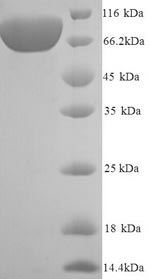A truncated version of Vascular cell adhesion protein 1 (VCAM1) encoding the extracellular domain and carrying a 6xHis-tag at the N-terminus was produced in the yeast. The resulting protein is a partial-length VCAM1 protein. It contains aa of 25-698 of the human VCAM1 protein. It was purified by SDS-PAGE and reached up to 90% in purity. On the reducing SDS-PAEG gel, this VCAM1 protein migrated on the molecular weight band of about 66-116 kDa. In addition to producing specific antibodies, the recombinant VCAM1 protein could also be used in the studies of VACM-related immunology or signal transduction.
VCAM-1, or called CD106, is a glycoprotein primarily expressed in endothelial cells. Pro-inflammatory cytokines, ROS, high glucose concentration, oxidized low-density lipoprotein, shear stress, and toll-like receptor agonists, can induce the expression of VCAM-1. VCAM-1 participates in the modulation of inflammation-associated vascular adhesion and the transendothelial migration of leukocytes. Recent studies show the close link of VCAM-1 to the progression of various immunological disorders, such as asthma, rheumatoid arthritis, transplant rejection, and cancer.




